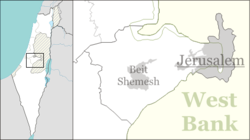Netiv HaLamed-Heh
Netiv HaLamed-Heh
נְתִיב הַל"ה | |
|---|---|
 View of Netiv HaLamed Heh | |
| Coordinates: 31°41′16″N 34°59′1″E / 31.68778°N 34.98361°E | |
| Country | Israel |
| District | Jerusalem |
| Council | Mateh Yehuda |
| Affiliation | Kibbutz Movement |
| Founded | 16 August 1949 |
| Founded by | Demobilised Harel Brigade soldiers |
| Population (2022) | 701[1] |
| Website | www |
Netiv HaLamed-Heh (Hebrew: נְתִיב הַל"ה, lit. 'Path of the 35') is a kibbutz in central Israel. Located in the Valley of Elah, it falls under the jurisdiction of Mateh Yehuda Regional Council. In 2022 it had a population of 701.[1]
History
[edit]Netiv HaLamed-Heh was established on 16 August 1949 by demobilised soldiers on land that had belonged to the depopulated Palestinian village of Bayt Nattif.[2] The soldiers had been members of the 4th Company of the Palmach's Harel Brigade, and the settlement was initially named Peled (an acronym for Pluga Daled, lit. Daled Company, daled being the 4th letter of the Hebrew alphabet).[citation needed] It was later renamed[citation needed] after the 35 Haganah soldiers killed in a convoy sent to resupply the Gush Etzion kibbutzim during the 1947–48 Civil War (Lamed-Heh is 35 in Hebrew numerals).[3]


In 2007, the Vertigo Dance Company has established the Vertigo Eco-Art Village as an educational center for ecology and arts at Kibbutz Netiv HaLamed-Heh.[4][5]
Notable people
[edit]- Yiftah Ron-Tal (born 1956), major general of the IDF (retired), head of the Port Authority (2007–2010) and the Israel Electric Corporation (since 2010)
- Ya'akov Tzur (born 1937), former politician and government minister in the 1980s–1990s
See also
[edit]References
[edit]- ^ a b "Regional Statistics". Israel Central Bureau of Statistics. Retrieved 21 March 2024.
- ^ Khalidi, Walid (1992). All That Remains: The Palestinian Villages Occupied and Depopulated by Israel in 1948. Washington D.C.: Institute for Palestine Studies. p. 212. ISBN 0-88728-224-5.
- ^ Netiv Ha-Lamed-He Jewish Virtual Library
- ^ Dance in Israel
- ^ Vertigo Eco-Art Village: "About us" (accessed January 2021)
External links
[edit]- Kibbutz website (in Hebrew)


